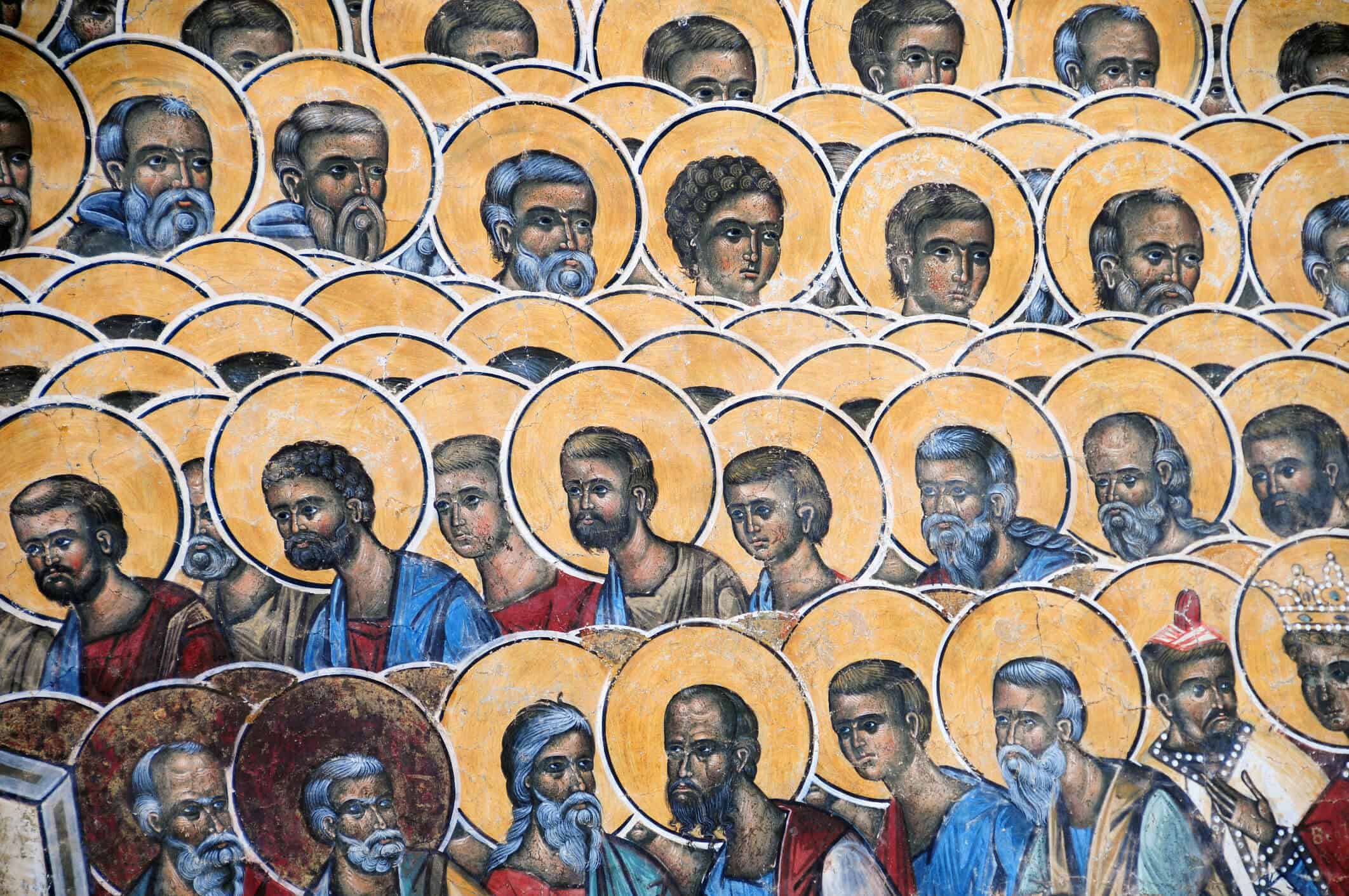February 2
The Presentation of the Lord
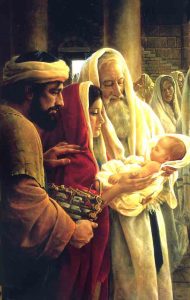
Today the Church celebrates the feast of the Presentation of the Lord which occurs forty days after the birth of Jesus and is also known as Candlemas day. Forty days after the solemnity of Christmas, Mary and Joseph consecrated Jesus in the Temple of Jerusalem, fulfilling the Mosaic Law.
Simeon and Anna were two venerable elderly people dedicated to prayer and fasting in the temple, and their strong religious spirit enabled them to recognize the Messiah. Simeon utters a prophecy that Jesus will be the light of the Gentiles and the glory of Israel. Anna thanks God for the child and talks about him to all who looked to God for the deliverance of Jerusalem.
Inspired by the words of the prophecy of Simeon, (“a light to the revelation of the Gentiles”), by the 11th century, the custom had developed in the West of blessing candles on the Feast of the Presentation. The candles were then lit, and a procession took place through the darkened church while the Canticle of Simeon was sung. Because of this, the feast also became known as Candlemas.
February 8
St. Josephine Bakhita
Josephine Margaret Bakhita was born around 1869 in the village of Olgossa in the Darfur region of Sudan. When she was 9 years old, Josephine was kidnapped by Arab slave traders. She was given the name Bakhita, which means fortunate. For the next 12 years she would be bought, sold and given away over a dozen times. She spent so much time in captivity that she forgot her original name. Her experience as a slave ranged from fair to cruel, depending on the owner; one cruelly and deliberately scarred and mutilated her. She was eventually sold to the Italian Vice Consul to Turkey and returned with him to Italy.
Her new family used her as a nanny. When her mistress left the country, she was placed with the Canossian Sisters in Venice. She was deeply moved by their faith and, when her mistress returned, refused to leave the convent. The courts eventually freed her, and she remained with the sisters. On January 9, 1890 she received the sacraments of initiation and took the name Josephine Margaret. She took her final vows as a Canossian sister six years later.
She remained in the convent for another 42 years, until her death in 1947. She was known for her gentle voice and smile and her gentle and charismatic personality. After a biography of her was published in 1930, she became a noted and sought after speaker, raising funds to support missions.
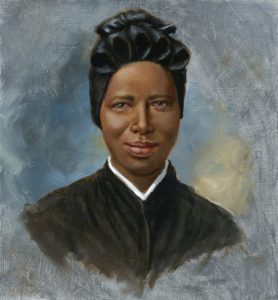
“If I were to meet the slave-traders who kidnapped me and even those who tortured me, I would kneel and kiss their hands, for if that did not happen, I would not be a Christian and Religious today… The Lord has loved me so much: we must love everyone… we must be compassionate!”
St. Josephine Bakhita
February 11
Our Lady of Lourdes
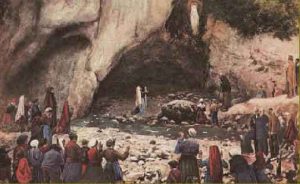
Prayer to Our Lady of Lourdes
Pope John Paul II (August 15, 2004.)
Hail Mary, lowly handmaid of the Lord,
Glorious Mother of Christ!
Faithful Virgin, holy dwelling-place of the Word,
Teach us to persevere in listening to the Word,
and to be docile to the voice of the Spirit, attentive to his promptings in the depths of our conscience
and to his manifestations in the events of history.
Holy Mary, Mother of believers,
Our Lady of Lourdes, pray for us.
On February 11, 1858, a young lady appeared to Bernadette Soubirous, a sickly child of poor parents living in the small town of Lourdes in south-western France. The lady instructed Bernadette to return to the grotto, where she appeared to the young peasant girl a total of 18 times. At one of these times, the lady instructed Bernadette to dig in a certain spot where a spring streamed forth. Almost immediately cures were reported by those who drank there.
During the apparition on March 25, the lady identified herself as the Immaculate Conception. Having only a very rudimentary knowledge of her faith, she did not understand the term, but reported it to her parish priest. Bernadette reported the desire of the lady that a chapel should be built at the grotto.
In 1862 Church authorities confirmed the authenticity of the apparitions and authorized the worshipt of Our Lady of Lourdes for the diocese. Today nearly 5,000,000 pilgrims visit the site every year, and it continues its history of miraculous healings. The Feast of Our Lady of Lourdes became worldwide in 1907.
February 14
Sts. Cyril and Methodius
These brothers, the Apostles of the Slavs, were born in Thessalonica, in 827 and 826 respectively. Though belonging to a senatorial family they renounced secular honours and became priests. They were living in a monastery on the Bosphorous, when the Khazars sent to Constantinople for a Christian teacher. Cyril was selected and was accompanied by his brother. They learned the Khazar language and converted many of the people. Soon after the Khazar mission there was a request from the Moravians for a preacher of the Gospel. German missionaries had already laboured among them, but without success. The Moravians wished a teacher who could instruct them and conduct Divine service in the Slavonic tongue. On account of their acquaintance with the language, Cyril and Methodius were chosen for their work. In preparation for it Cyril invented an alphabet and, with the help of Methodius, translated the Gospels and the necessary liturgical books into Slavonic. They went to Moravia in 863, and laboured for four and a half years. Despite their success, they were regarded by the Germans with distrust, first because they had come from Constantinople where schism was rife, and again because they held the Church services in the Slavonic language. On this account the brothers were summoned to Rome by Nicholas I, who died, however, before their arrival. His successor, Adrian II, received them kindly. Convinced of their orthodoxy, he commended their missionary activity, sanctioned the Slavonic Liturgy, and ordained Cyril and Methodius bishops. Cyril, however, was not to return to Moravia. He died in Rome, 4 Feb., 869.
At the request of the Moravian princes, Rastislav and Svatopluk, and the Slav Prince Kocel of Pannonia, Adrian II formed an Archdiocese of Moravia and Pannonia, made it independent of the German Church, and appointed Methodius archbishop. In 870 King Louis and the German bishops summoned Methodius to a synod at Ratisbon. Here he was deposed and condemned to prison. After three years he was liberated at the command of Pope John VIII and reinstated as Archbishop of Moravia. He zealously endeavoured to spread the Faith among the Bohemians, and also among the Poles in Northern Moravia. Soon, however, he was summoned to Rome again in consequence of the allegations of the German priest Wiching, who impugned his orthodoxy, and objected to the use of Slavonic in the liturgy. But John VIII, after an inquiry, sanctioned the Slavonic Liturgy, decreeing, however, that in the Mass the Gospel should be read first in Latin and then in Slavonic. Wiching, in the meantime, had been nominated one of the suffragan bishops of Methodius. He continued to oppose his metropolitan, going so far as to produce spurious papal letters. The pope, however, assured Methodius that they were false. Methodius went to Constantinople about this time, and with the assistance of several priests, he completed the translation of the Holy Scriptures, with the exception of the Books of Machabees. He translated also the “Nomocanon”, i.e. the Greek ecclesiastico-civil law. The enemies of Methodius did not cease to antagonize him. His health was worn out from the long struggle, and he died 6 April, 885, recommending as his successor Gorazd, a Moravian Slav who had been his disciple.
Formerly the feast of Saints Cyril and Methodius was celebrated in Bohemia and Moravia on 9 March; but Pius IX changed the date to 5 July. Leo XIII, by his Encyclical “Grande Munus” of 30 September, 1880, extended the feast to the universal Church.
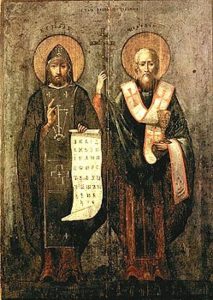
“Behold, my brother, we have shared the same destiny, ploughing the same furrow; I now fall in the field at the end of my day. I know that you greatly love your Mountain; but do not for the sake of the Mountain give up your work of teaching.”
St. Cyril, Monk, on his deathbed to St. Methodius, Bishop
February 17
The Seven Holy Founders of the Servite Order
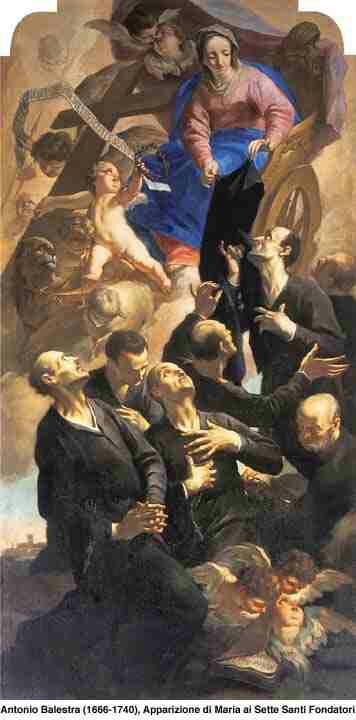
These seven men, by name Bonfilius, Alexis, Manettus, Amideus, Hugh, Sostene and Buonagiunta of Florence, were the founders of the Servite Order, a community instituted for the special purpose of cultivating the spirit of penance and contemplating the passion of Christ and Mary’s Seven Sorrows. Due to the spirit of humility cherished by the members of the Order, their accomplishments are not too widely known. But in the field of home missions great things are to their credit, and certainly they have benefited millions by arousing devotion to the Mother of Sorrows.
The Breviary tells us that in the midst of the party strife during the thirteenth century, God called seven men from the nobility of Florence. In the year 1233 they met and prayed together most fervently. The Blessed Mother appeared to each of them individually and urged them to begin a more perfect life. Disregarding birth and wealth, in sackcloth under shabby and well-worn clothing they withdrew to a small building in the country. It was September 8, selected so that they might begin to live a more holy life on the very day when the Mother of God began to live her holy life.
Soon after, when the seven were begging alms from door to door in the streets of Florence, they suddenly heard children’s voices calling to them, “Servants of holy Mary.” Among these children was St. Philip Benizi, then just five months old. Hereafter they were known by this name, first heard from the lips of children. In the course of time they retired into solitude on Monte Senario and gave themselves wholly to contemplation and penance. Leo XIII canonized the Holy Founders and introduced today’s feast in 1888.
February 20
Sts. Jacinta and Francisco Marto
Between May 13 and October 13, 1917, the Blessed Virgin Mary appeared six times near Fatima, a city 110 miles north of Lisbon. She visited three Portuguese shepherd children: Lúcia dos Santos and her cousins Jacinta and Francisco Marto, Portuguese shepherds from Aljustrel. At that time, Europe was involved in an extremely bloody war. Portugal itself was in political turmoil, having overthrown its monarchy in 1910; the government disbanded religious organizations soon after.
At the first appearance, Mary asked the children to return to that spot on the thirteenth of each month for the next six months. Mary repeatedly asked the children to offer themselves in prayer and penance “to obtain peace for the world and the end of the war,” the First World War then ravaging Europe. They were to pray for sinners and for the conversion of Russia, which had recently overthrown Czar Nicholas II and was soon to fall under communism. Up to 90,000 people gathered for Mary’s final apparition on October 13, 1917.
Of the three children, Francisco alone was unable to hear Mary, although he saw her and felt her presence. But, in him as in the others, the apparitions would effect a profound change. Light-hearted and even mischievous before the apparitions, afterward Francisco became serious beyond his years, sneaking often to the church to pray before the tabernacle, the “hidden Jesus.” His father once found him quite sad because of the “sins that were committed against Jesus.” Francisco insisted that he wanted, above all, “to console Jesus and make him happy.” He once said he did not want to grow up but only to “go to heaven.” When Francisco and Jacinta contracted the Spanish Flu, they continued their daily prayers and penances. Francisco begged for and received his First Holy Communion on April 3, 1919. He died the next day, at the age of eleven, with a smile on his face. He was buried in the parish cemetery and then re-buried in the Fatima basilica in 1952.
Only seven at the time of the first appearance, Jacinta exuberantly shared the story with her mother. When word spread, the children were exposed to endless questions and ridicule, yet all three hearkened to the Blessed Mother’s words: “Pray, pray much and make sacrifices for sinners; many souls go to hell because they have no one to pray and make sacrifices for them.” Jacinta led the others in the daily sacrifices; she willingly gave her lunch to the poor and fasted from water in the heat of the day. After contracting the Spanish flu in 1918, Jacinta patiently endured painful treatments until her death in February 1920. When her body was exhumed fifteen years later, it was found to be incorrupt. She was re-buried in the Fatima basilica in 1951.
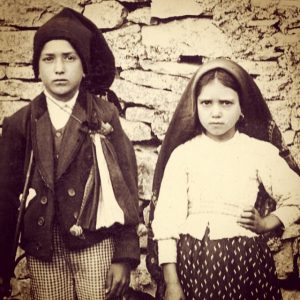
“We were burning in that light which is God and we were not consumed.
St. Francisco Marto
“What is God like?
“It is impossible to say. In fact, we will never be able to tell people”
February 22
Feast of the Chair of St. Peter
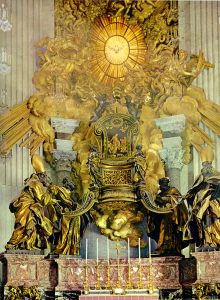
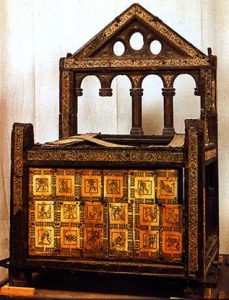
The feast of the Chair of St. Peter is a commemoration of the founding of the Church when Christ said, “You are Peter and on this rock I will build my Church.” It has been celebrated at Rome, Italy from the early days of the Christian era on 18 January, in commemoration of the day when Saint Peter held his first service in Rome. This feast commemorates Christ’s choosing Peter to sit in his place as the servant-authority of the whole Church. It has been celebrated at Rome, Italy from the early days of the Christian era on 18 January, in commemoration of the day when Saint Peter held his first service in Rome. The feast of the Chair of Saint Peter at Antioch, commemorating his foundation of the See of Antioch, has also been long celebrated at Rome, on 22 February.
On the one hand, there is a physical object. In Rome an ancient, ornamented chair is located in the apse of St. Peter’s Basilica, and surrounded by a Bernini altarpiece. In Antioch an even more ancient chair, dating to the second century, is venerated. In 2006 Pope Benedict stated, “This is a very ancient tradition, proven to have existed in Rome since the fourth century. On it we give thanks to God for the mission he entrusted to the Apostle Peter and his Successors. The Chair of St Peter . . . is a symbol of the special mission of Peter and his Successors to tend Christ’s flock, keeping it united in faith and in charity.”
This chair represents the authority of our church’s leaders, stretching back to St. Peter. Like a committee chair, this chair refers to the occupant, not the furniture. Its first occupant stumbled a bit, denying Jesus three times and hesitating to welcome Gentiles into the new Church. Some of its later occupants have also stumbled a bit, sometimes even failed scandalously. As individuals, we may sometimes think a particular pope has let us down. Still, the office endures as a sign of the long tradition we cherish and as a focus for the universal Church.
February 27
St. Gabriel of Our Lady of Sorrows
Francesco Possenti was born on 1 March 1838, in Assisi, Italy, the eleventh of thirteen children. While he was only 4 years old, his family suffered the loss of their infant daughter Rosa, 7-year old Adele; and their mother, Agnes. Although he was known for his piety, he was something of a ladies man, and was fond of music and dancing, of theater and hunting.
In 1851, he was afflicted with a serious illnesses, and promised to enter religious life if cured. He was cured, but ignored his promise. After a second illness two years later, he made the same promise, and this time actually carried it out. During a procession honoring the Virgin Mary, he heard a voice asking why he remained in his secular life. He entered a Passionist Congregation monastery in 1856, and reflecting his deep devotion, he was given the religious name of Gabriel of Our Lady of Sorrows.
Gabriel was an excellent student, and was unfailingly cheerful and considerate of others. His superiors expected great things of him as he studied for the priesthood but around 1859 he began to exhibit symptoms of tuberculosis. He embraced his final lingering illness with joy, because it gave him the opportunity to prepare for his death. He died from tuberculosis in 1862 at age 24, in the company of his fellow Passionists, holding an image of Our Lady of Sorrows and smiling peacefully.
His life in the monastery was not exceptional; like St. Therese of Lisieux he sought holiness in prayerful and faithful attendance to the details of every day monastic life. He gained his end, not by vainly longing to do great things that might never be given him to do, not by waiting for opportunities that might never occur, but by doing with all his might whatsoever his hand found to do.
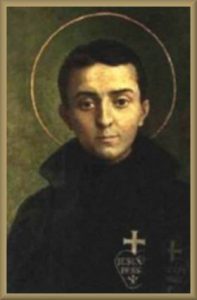
“Mary does not look to see what kind of person you have been. She simply comes to a heart that wants to love her. She comes quickly and opens her merciful heart to you, embraces you and consoles and serves you.”
St. Gabriel of Our Lady of Sorrows
